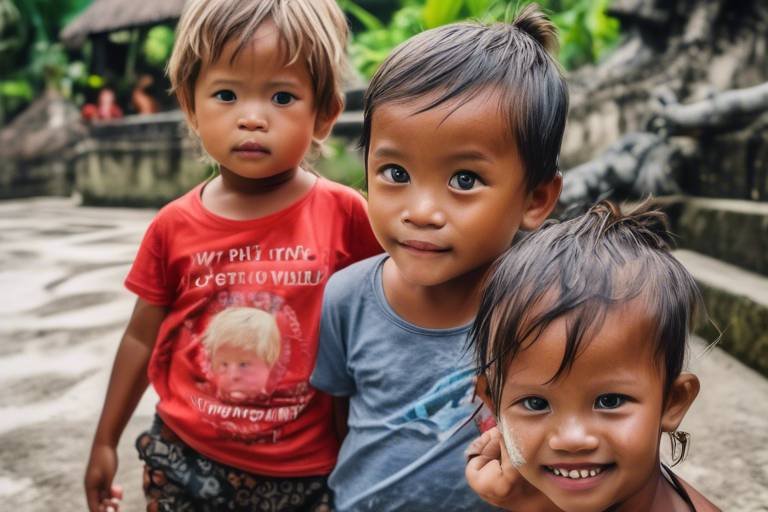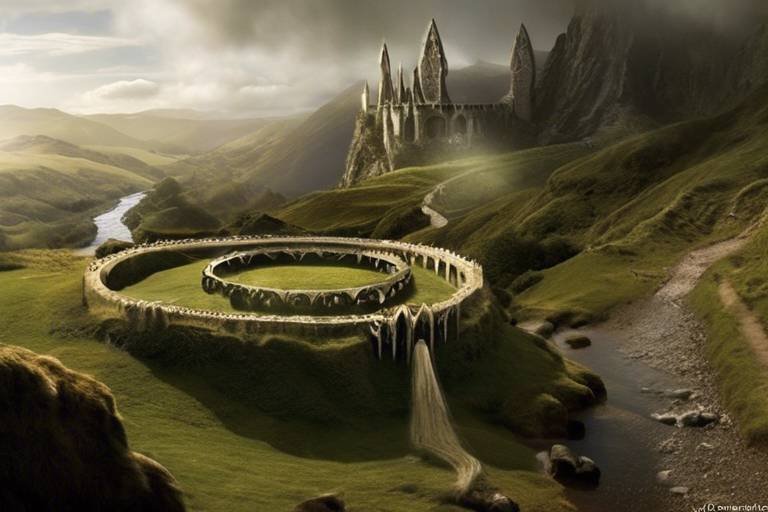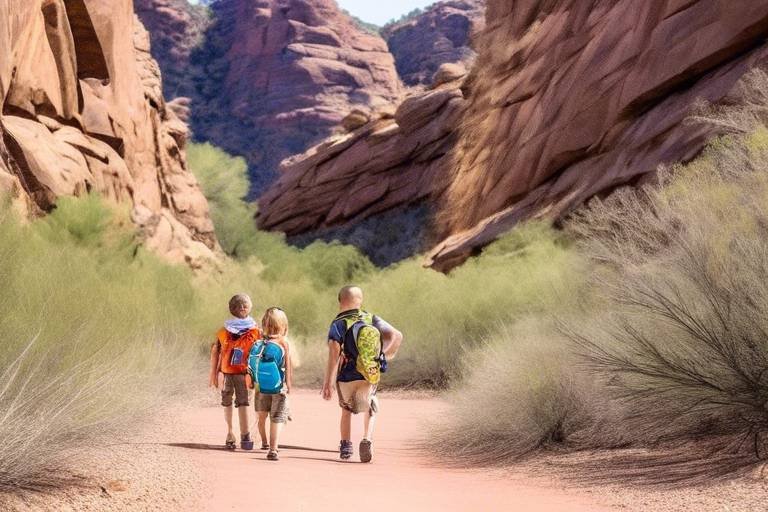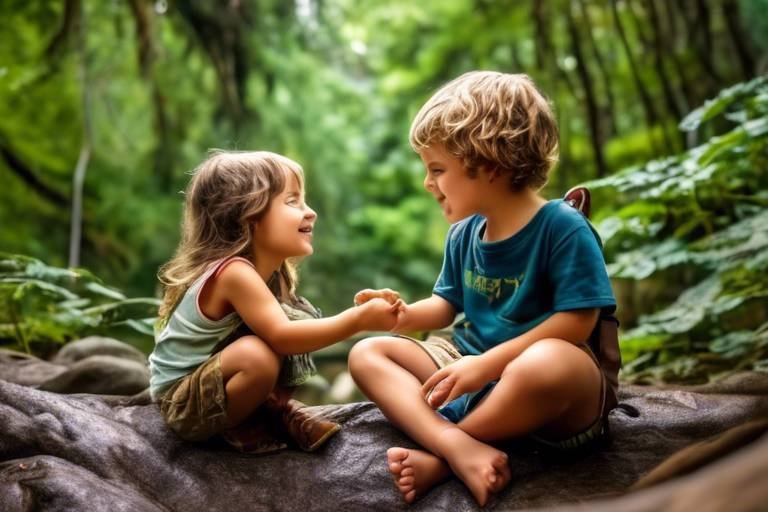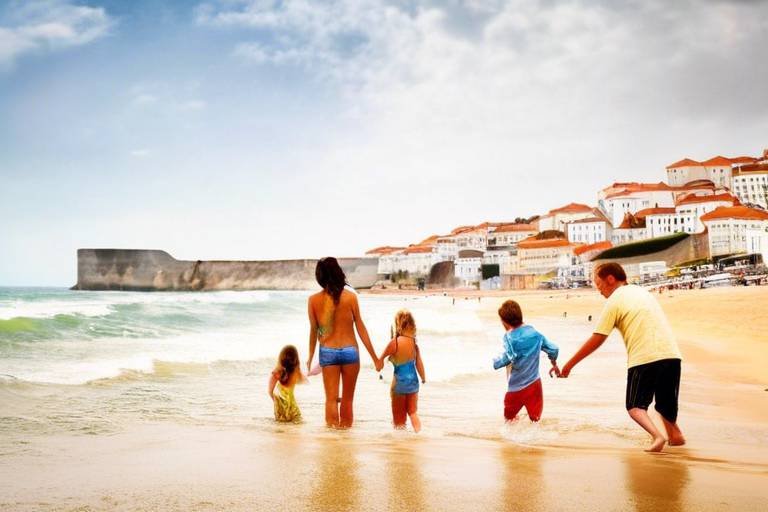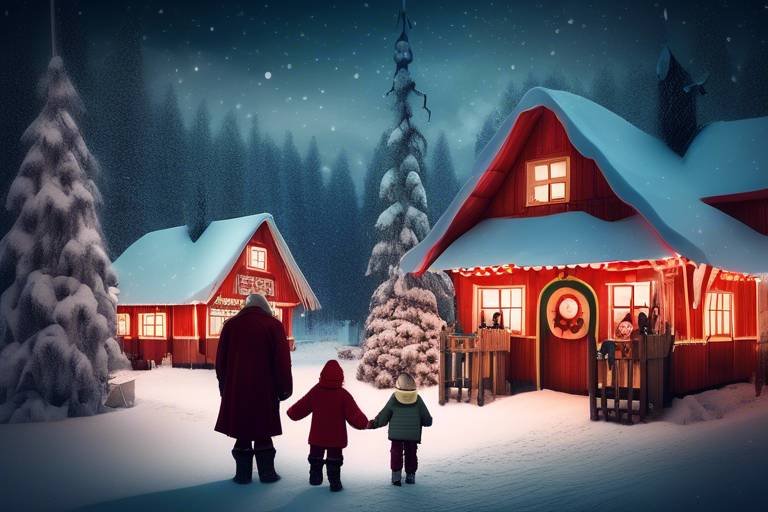Enjoying Nature with Your Kids in Canada
Canada is a treasure trove of natural wonders, just waiting for families to explore together. Imagine the laughter of your children echoing through the trees, the thrill of spotting a deer in the wild, or the joy of roasting marshmallows over a campfire. This vast country offers endless opportunities to connect with nature, and what better way to create lasting memories than by embarking on outdoor adventures with your kids? In this article, we'll dive into various activities and locations that not only foster a love for the great outdoors but also provide a backdrop for unforgettable family bonding experiences.
From the majestic peaks of the Rockies to the serene shores of the Atlantic, Canada’s diverse landscapes are like a canvas painted with adventure. Whether you're hiking, camping, or simply enjoying a picnic, the great outdoors beckons families to step outside and embrace the beauty around them. Plus, engaging with nature has proven benefits for children, including improved mood, enhanced creativity, and a stronger connection to the environment. So, pack your bags, grab your kids, and let’s explore the wonders of nature together!
Canada's national parks are the crown jewels of the great outdoors, offering breathtaking landscapes and diverse wildlife that make them perfect for family adventures. Each park has its unique charm and a plethora of activities suitable for kids of all ages. Imagine wandering through the towering trees of Banff National Park, spotting elk grazing in the meadows, or taking a family picture in front of the stunning turquoise waters of Lake Louise. These experiences not only captivate the imagination but also instill a sense of wonder in young hearts.
Here are a few must-visit national parks in Canada for family fun:
- Banff National Park - Famous for its stunning mountain scenery and wildlife.
- Jasper National Park - Known for its starry skies and family-friendly trails.
- Gros Morne National Park - Offers unique geological features and beautiful hiking paths.
- Pacific Rim National Park Reserve - Perfect for beach lovers and wildlife watchers.
These parks not only provide a playground for exploration but also serve as classrooms where kids can learn about ecology, conservation, and the importance of preserving our natural world. So, why not plan your next family getaway to one of these stunning locations?
When it comes to outdoor activities, Canada is a goldmine! From hiking and biking to canoeing and camping, the options are virtually limitless. Engaging children in outdoor activities not only keeps them active but also teaches them valuable life skills. For instance, hiking allows kids to develop resilience, while camping fosters teamwork and responsibility. Imagine your children learning to pitch a tent, or navigating a trail with a compass—these are the moments that build confidence and create stories to tell for years to come!
Let’s take a closer look at some family-friendly outdoor activities:
- Hiking - A great way to explore nature while getting some exercise.
- Biking - Perfect for families who love to speed through scenic trails.
- Canoeing - Offers a unique perspective of lakes and rivers.
- Camping - An adventure that brings families closer together.
Each activity presents its own set of challenges and rewards, making them perfect for kids to learn and grow while having fun. So, whether you're trekking through the woods or paddling across a serene lake, the possibilities for adventure are endless!
Finding suitable hiking trails for young adventurers is essential. Luckily, Canada is filled with family-friendly trails that are easy to navigate and offer engaging sights to keep kids interested and motivated. For example, the Emerald Lake Loop in Yoho National Park is a relatively flat trail that wraps around a stunning lake, perfect for little legs. Or consider the Capilano Suspension Bridge Park in Vancouver, where kids can walk across a swaying bridge and explore treetop walkways, all while soaking in the breathtaking views.
Safety is paramount when hiking with children. Here are some essential tips to ensure a safe and enjoyable hiking experience for the whole family:
- Plan Ahead: Research trails and check weather conditions.
- Pack Essentials: Bring water, snacks, and a first-aid kit.
- Dress Appropriately: Wear suitable clothing and sturdy footwear.
- Stay Together: Keep an eye on your kids and ensure they stay close.
Choosing the right gear for children can enhance their hiking experience significantly. Here are some essentials that ensure comfort and safety for young explorers:
- Comfortable Footwear: Invest in good quality hiking shoes.
- Weather-Appropriate Clothing: Layering is key for changing conditions.
- Backpacks: A lightweight pack can help them carry their snacks and water.
With the right preparation and gear, hiking can be a fantastic way for families to bond while exploring the great outdoors!
Camping is another fantastic way to immerse kids in nature. The crackling of the campfire, the rustle of leaves in the wind, and the twinkling stars overhead create an enchanting atmosphere that kids will remember forever. To ensure a successful family camping trip, consider these tips:
- Campsite Selection: Choose a site that is family-friendly and has amenities.
- Activities: Plan games, hikes, and storytelling sessions.
- Meal Planning: Involve kids in preparing simple meals over the fire.
With these tips in mind, camping can be an adventure that not only teaches children about nature but also strengthens family bonds.
Canada is home to incredible wildlife, and witnessing these creatures in their natural habitats can be a thrilling experience for kids. From the majestic moose to playful otters, there’s so much to see! Discovering the best locations and practices for safe and educational wildlife watching experiences captivates children and fosters a sense of wonder about the natural world.
Bird watching can be a fun and educational activity for kids. Equip them with binoculars and a simple field guide, and they’ll be ready to spot everything from vibrant cardinals to majestic eagles. Local parks, nature reserves, and even your backyard can provide opportunities for bird watching. Encourage your kids to keep a journal of the birds they see, noting colors, behaviors, and even sketches to enhance their learning experience!
Teaching children about responsible wildlife viewing is crucial. Here are some best practices to ensure both safety and respect for animals in their natural habitats:
- Maintain Distance: Always observe wildlife from a safe distance.
- Do Not Feed Animals: Feeding wildlife can harm them and alter their natural behavior.
- Follow Guidelines: Adhere to park rules and regulations regarding wildlife viewing.
By instilling these values in children, we can help them develop a sense of responsibility and respect for the wildlife that shares our planet.
Q: What are some great places for family hikes in Canada?
A: Some top spots include Banff National Park, Jasper National Park, and Gros Morne National Park, which all offer trails suitable for families.
Q: How can I keep my kids engaged during outdoor activities?
A: Incorporate games, scavenger hunts, and educational activities to keep them interested and excited about their surroundings.
Q: What should I pack for a family camping trip?
A: Essentials include a tent, sleeping bags, cooking gear, food, water, and safety items like a first-aid kit.

Exploring National Parks
Canada's national parks are like a treasure chest filled with the most stunning landscapes and rich biodiversity, making them the perfect playground for families looking to bond over nature. Imagine breathing in the fresh, crisp air while surrounded by towering trees, majestic mountains, and glistening lakes. It's not just about the scenery; it’s about the experiences you’ll create with your children. Each park offers unique opportunities for adventure, whether it’s spotting wildlife, hiking scenic trails, or simply enjoying a picnic in a picturesque setting.
Some of the most popular national parks to explore include:
- Banff National Park: Famous for its turquoise lakes and stunning mountain views, Banff is a year-round destination. Families can enjoy activities like hiking, skiing, and even hot springs!
- Jasper National Park: Known for its dark skies and incredible stargazing opportunities, Jasper offers a range of family-friendly activities, from wildlife tours to canoeing on serene lakes.
- Yoho National Park: This hidden gem is home to breathtaking waterfalls and unique geological features. The easy trails here are perfect for families with young children.
Exploring these parks not only provides a chance to connect with nature, but it also allows children to learn about the environment and conservation. Each visit can be an educational adventure. For instance, while hiking, you can teach your kids about the different types of trees and wildlife they encounter. It’s like a live classroom, but with a much cooler view!
Moreover, many national parks offer guided tours and educational programs specifically designed for kids. These programs can include nature walks, animal tracking, and interactive workshops that make learning fun. Just imagine your child's face lighting up when they spot a deer or learn how to identify various bird calls! Such experiences foster a sense of curiosity and respect for nature, which is essential in today’s digital age.
When planning your visit, consider the time of year, as each season brings its own unique charm. Summer is great for hiking and camping, while fall showcases vibrant foliage. Winter opens doors to snowshoeing and skiing, and spring is a magical time for wildflowers and baby animals. No matter when you go, there’s always something special waiting for you in Canada’s national parks.
To help you plan your adventure, here’s a quick table summarizing some key features of popular national parks:
| Park Name | Location | Activities | Best Time to Visit |
|---|---|---|---|
| Banff National Park | Alberta | Hiking, Skiing, Hot Springs | Summer & Winter |
| Jasper National Park | Alberta | Wildlife Tours, Canoeing, Stargazing | Year-round |
| Yoho National Park | British Columbia | Hiking, Photography, Waterfalls | Summer & Fall |
In conclusion, exploring Canada’s national parks is more than just a family outing; it's an opportunity to create lasting memories and instill a love for the outdoors in your children. So pack your bags, grab your hiking boots, and get ready for an adventure that your family will cherish for years to come!

Outdoor Activities for Families
When it comes to spending quality time with your kids in the great outdoors, Canada has an abundance of options that are both exciting and educational. From the majestic mountains to serene lakes, your family can engage in a variety of activities that not only promote physical health but also foster a deeper connection with nature. Imagine the joy on your children's faces as they explore the vast wilderness, discovering new things at every turn. Whether you are seasoned adventurers or just starting, there's something for everyone!
One of the most popular outdoor activities is hiking. There’s nothing quite like the thrill of hitting the trails together, breathing in the fresh air, and soaking in the stunning views. The beauty of hiking is that it can be tailored to suit every family’s skill level. For younger children, consider trails that are easy to navigate and offer plenty of engaging sights. Think about trails that have interesting rock formations, vibrant wildflowers, or even small streams where kids can splash around. It’s not just about reaching the destination; it’s about the journey and the stories you create along the way!
Another fantastic way to immerse your family in nature is through camping. There’s something magical about sleeping under the stars, roasting marshmallows over a campfire, and listening to the sounds of the night. Camping allows children to disconnect from their screens and connect with the natural world around them. When planning a camping trip, consider family-friendly campsites that provide amenities such as clean restrooms and picnic areas. This way, you can focus on enjoying your time together without the stress of roughing it too much.
In addition to hiking and camping, Canada offers countless opportunities for water-based activities. Canoeing and kayaking are excellent choices for families looking to enjoy the water while getting a bit of exercise. Paddling on a tranquil lake can be a serene experience, and it’s a great way to teach your kids about teamwork and cooperation. Just imagine gliding across the water, surrounded by lush forests and the sounds of nature—what a perfect way to bond!
For those who prefer a bit more adrenaline, biking through scenic trails can be exhilarating. Many national parks have dedicated bike paths that are safe for families. Riding together not only builds strength and endurance but also creates lasting memories. As you zip along the trails, you might even spot some wildlife, which adds an element of surprise and excitement to your adventure.
To ensure that your family enjoys these outdoor activities to the fullest, it's essential to keep safety in mind. Always check the weather forecast before heading out, pack plenty of water and snacks, and make sure everyone is wearing appropriate clothing. Having a first-aid kit on hand is also a smart move. Remember, the goal is to have fun and create memories, so being prepared will help you avoid any unnecessary hiccups!
In summary, Canada’s vast landscapes offer endless possibilities for outdoor family activities. Whether you're hiking, camping, canoeing, or biking, the experiences you share will not only enrich your lives but also instill a lifelong love for nature in your children. So, grab your gear, gather the family, and get ready for an unforgettable adventure!
- What are some beginner-friendly hiking trails in Canada?
Some great beginner-friendly trails include the Emerald Lake Loop in Yoho National Park and the Lake Louise Lakeshore Trail in Banff National Park.
- What should I pack for a family camping trip?
Essential items include a tent, sleeping bags, cooking utensils, food, water, and first-aid supplies. Don’t forget games and books for entertainment!
- Are there guided outdoor activities available for families?
Yes, many national parks offer guided tours and activities, which can be a great way to learn about the area while ensuring safety.

Hiking Trails for Kids
Finding the perfect hiking trails for young adventurers can be both exciting and challenging. It’s essential to choose paths that are not only easy to navigate but also offer engaging sights to keep kids interested and motivated. After all, hiking with children should be an adventure filled with discovery, laughter, and a bit of wonder. Imagine walking through a lush forest where the trees seem to whisper secrets, or crossing a bubbling brook that invites you to explore further. These experiences can ignite a lifelong love for nature in your little ones.
When selecting hiking trails, consider the difficulty level and the distance. Trails that are too long or challenging may lead to frustration, while shorter, scenic routes can keep spirits high. For families with younger kids, look for trails that are under 3 kilometers (about 2 miles) and feature plenty of opportunities for breaks, such as picnic spots or lookout points. This way, you can take your time, enjoy the surroundings, and allow the kids to explore at their own pace.
Here are a few fantastic hiking trails across Canada that are perfect for families with children:
- Banff National Park - Tunnel Mountain Trail: This is a short, easy hike that offers stunning views of the town of Banff and the surrounding mountains. The trail is well-marked and features a gradual incline, making it accessible for kids.
- Gatineau Park - Pink Lake Trail: This trail is approximately 2 kilometers long and features a boardwalk that leads to beautiful views of Pink Lake. Kids will love spotting wildlife along the way!
- Pacific Rim National Park - Rainforest Trail: A unique experience where kids can walk through lush, ancient rainforests, complete with interpretive signs that educate them about the ecosystem.
As you embark on these adventures, don’t forget to bring along a nature journal. Encourage your kids to document their findings—whether it’s a vibrant leaf, a unique rock, or even a sketch of a bird they spotted. This not only makes the hike more interactive but also instills a sense of curiosity and appreciation for the natural world.
In addition to the physical activity, hiking is a great opportunity to bond as a family. Share stories, play games, or even sing songs to keep the energy up. By creating a fun atmosphere, you’ll help your children associate hiking with joy and exploration, paving the way for future adventures together.
Remember, the goal is to make hiking enjoyable and engaging for kids. So, take the time to choose trails that will spark their interest and curiosity. Whether it’s spotting wildlife, collecting interesting rocks, or simply enjoying the beauty of the great outdoors, these experiences will create lasting memories and foster a love for nature.
Q: What should I pack for a family hike?
A: It's essential to pack water, snacks, a first-aid kit, sunscreen, and appropriate clothing for the weather. Don't forget a camera to capture those beautiful moments!
Q: How can I keep my kids motivated during a hike?
A: Make the hike fun by incorporating games, setting small goals, and taking breaks to explore. Let them lead the way occasionally to give them a sense of adventure.
Q: Are there any safety tips I should be aware of?
A: Always stay on marked trails, keep an eye on your children, and ensure they have proper footwear. It's also a good idea to familiarize yourself with the area before going.

Safety Tips for Hiking
When it comes to hiking with your kids, safety should always be your top priority. Imagine embarking on an exciting adventure through the lush forests of Canada, only to find yourself unprepared for the challenges that lie ahead. To ensure that your family enjoys every moment of your hike, here are some essential safety tips that will help keep everyone safe and sound.
First and foremost, planning is key. Before heading out, research your chosen trail. Look for information on trail difficulty, length, and any potential hazards. Make sure to choose a trail that is appropriate for the ages and abilities of your children. If you're hiking with toddlers, opt for shorter, easier trails that offer plenty of opportunities for exploration and play.
Next, gear up properly. Ensure that everyone in the family has the right equipment, including sturdy hiking shoes, weather-appropriate clothing, and a well-fitted backpack. Don’t forget to pack essentials like water, snacks, a first-aid kit, and a map or GPS device. Remember, carrying a little extra weight is worth it for safety and comfort!
Another important aspect is to set clear boundaries. Kids are naturally curious and may wander off the trail. Teach them the importance of staying on the marked path and keeping a safe distance from the edge of cliffs or steep drop-offs. Reinforce these rules with fun reminders, like pretending to be explorers on a quest to discover hidden treasures!
Always keep an eye on the weather forecast before your hike. The weather can change rapidly, especially in the mountains. If you notice dark clouds rolling in or the temperature dropping, it might be wise to cut your hike short. Remember, it’s better to turn back and live to hike another day than to risk getting caught in a storm.
Finally, consider using a hiking buddy system. Pair up your kids and encourage them to look out for one another. This not only promotes teamwork but also allows them to feel a sense of responsibility. Plus, it can lead to some memorable moments as they share their discoveries along the trail.
In summary, hiking with kids can be an incredibly rewarding experience if you take the necessary precautions. By planning ahead, gearing up properly, setting boundaries, monitoring the weather, and implementing a buddy system, you can ensure that your family adventure is both safe and enjoyable. So, lace up those hiking boots, pack your bags, and get ready to make unforgettable memories in the great outdoors!
Q: What should I do if my child gets tired during a hike?
A: If your child becomes tired, it’s important to take a break. Find a safe, comfortable spot to rest, hydrate, and have a snack. If they’re still too tired to continue, consider turning back or carrying them in a child carrier if necessary.
Q: How can I teach my kids about nature while hiking?
A: Use the hike as an opportunity to explore. Encourage your kids to observe plants, animals, and insects. Bring along a nature guidebook or download an app to help identify different species. Make it a fun learning experience!
Q: What should I do in case of an emergency?
A: Always carry a first-aid kit and know basic first-aid skills. If an emergency arises, stay calm and assess the situation. If you have cell service, call for help. If not, try to find a safe way to return to your starting point or seek assistance from fellow hikers.

Best Hiking Gear for Kids
When it comes to hiking with kids, having the right gear can make all the difference in ensuring a fun and safe adventure. Kids are naturally curious and energetic, but they can also be sensitive to the elements and their surroundings. Therefore, investing in quality hiking gear is essential. Let's dive into the must-haves that will keep your little explorers comfortable and eager to hit the trails!
First and foremost, a good pair of hiking boots is crucial. Look for boots that provide ankle support, a sturdy sole, and are waterproof. Kids tend to be adventurous, often splashing through puddles or climbing over rocks, so having footwear that can withstand the elements is key. Make sure to get the right fit; boots that are too tight can cause blisters, while loose ones can lead to slips and falls.
Next up is clothing. Layering is your best friend when hiking with kids. Start with a moisture-wicking base layer to keep them dry, add an insulating layer for warmth, and finish with a waterproof and breathable outer layer. A good rule of thumb is to dress kids in synthetic fabrics rather than cotton, as cotton retains moisture and can lead to discomfort. Don’t forget about accessories like a wide-brimmed hat for sun protection and a lightweight pair of gloves if you're hiking in cooler weather.
Hydration is another vital aspect of hiking. Kids can easily become dehydrated, especially on warm days or during strenuous activities. A hydration pack or a water bottle designed for kids will encourage them to drink more often. Look for bottles with fun designs that your child will love to carry. It's also a good idea to pack some healthy snacks to keep their energy levels up. Think trail mix, granola bars, or fruit—easy-to-carry options that provide a quick energy boost!
Finally, don’t overlook the importance of a first aid kit. While we hope for the best, it’s always wise to be prepared for minor scrapes or insect bites. A compact kit that includes band-aids, antiseptic wipes, and allergy medication can be a lifesaver. You can even involve your kids in the preparation process by letting them help pack the kit, which can teach them valuable lessons about safety and responsibility.
In summary, equipping your kids with the right hiking gear not only enhances their experience but also instills a sense of adventure and responsibility. The right boots, layered clothing, hydration options, snacks, and a first aid kit will ensure that your family hikes are enjoyable and safe. So, are you ready to gear up and hit the trails with your little adventurers?
Q: What is the best age to start hiking with kids?
A: Kids can start hiking as early as toddler age, but it’s important to choose trails that are suitable for their skill level. Short, flat trails are ideal for younger children.
Q: How long should we hike with kids?
A: Start with shorter hikes, around 1-2 miles, and gradually increase the distance as your kids become more comfortable and confident.
Q: What should I do if my child gets tired on a hike?
A: Take regular breaks, offer snacks, and encourage them to enjoy the surroundings. If they are too tired to continue, it’s best to head back or find a safe spot to rest.
Q: How can I make hiking more enjoyable for my kids?
A: Engage them with games, such as scavenger hunts or bird watching. Let them lead the way occasionally to give them a sense of ownership over the adventure!

Camping with Children
Camping with children is not just about spending a night under the stars; it’s an adventure that can ignite their imagination and foster a deep appreciation for nature. Imagine your kids roasting marshmallows over a crackling fire, sharing stories that echo through the trees, and gazing up at a sky sprinkled with stars. It’s these moments that create lasting memories and strengthen family bonds. However, a successful camping trip requires a bit of planning and consideration to ensure that everyone has a great time.
First and foremost, choosing the right campsite is crucial. Look for family-friendly campgrounds that offer amenities such as restrooms, picnic tables, and fire pits. Many parks have designated family areas that are perfect for those with young children. You want a spot that’s not too remote but still allows for a sense of adventure. Additionally, consider the proximity to hiking trails or lakes. This way, you can easily engage in various activities without having to travel far.
Once you’ve secured your campsite, it’s time to think about activities. Kids love to explore, so plan some fun and engaging activities that allow them to connect with nature. Here are a few ideas:
- Nature Scavenger Hunt: Create a list of items for your kids to find, such as pinecones, specific leaves, or animal tracks. This activity encourages observation and curiosity.
- Star Gazing: Bring a telescope or simply lie on a blanket to watch the stars. Teach your kids about constellations and the stories behind them.
- Campfire Stories: Gather around the fire and share stories. This is a great way to bond and spark creativity in your children.
Meal planning is another essential aspect of camping with kids. Involve your children in the process by letting them help choose meals and snacks. This not only makes them excited about the trip but also teaches them valuable skills. Opt for simple, easy-to-cook meals that require minimal preparation. Think hot dogs, grilled cheese, or foil packet meals. Don’t forget to pack plenty of snacks like trail mix, fruit, and granola bars to keep their energy up during activities.
Lastly, safety should always be a top priority. Ensure that your children understand basic camping safety rules, such as staying close to the campsite and not wandering off alone. Equip them with age-appropriate gear, and make sure they have a comfortable sleeping arrangement. A good night’s sleep is essential for happy campers! Remember, camping is meant to be fun, so don’t stress too much about the little things. Embrace the unpredictability of the outdoors, and enjoy the adventure together as a family.
Q: What age is appropriate for children to go camping?
A: Generally, children as young as three can enjoy camping experiences, but it depends on the child's comfort level and the family's camping style. Start with short trips and gradually increase the duration as they grow.
Q: What should I pack for camping with kids?
A: Essential items include sleeping bags, a tent, first aid kit, insect repellent, sunscreen, cooking gear, and plenty of snacks. Don’t forget their favorite toys or books to keep them entertained!
Q: How can I keep my kids engaged while camping?
A: Plan activities such as hiking, fishing, nature crafts, and games. Involve them in cooking and setting up the campsite to make them feel included and excited.

Wildlife Watching
When you think of Canada, what comes to mind? The stunning landscapes? The friendly people? Well, let me tell you, one of the most thrilling aspects of this vast country is its wildlife. From the majestic moose roaming the forests to the playful otters splashing in the rivers, Canada offers a wildlife watching experience that can ignite a sense of wonder in both kids and adults alike. Imagine the excitement on your child's face when they spot a bald eagle soaring overhead or catch a glimpse of a family of deer grazing peacefully in a meadow. These moments create lasting memories and foster a deep appreciation for nature.
There are countless locations across Canada that are perfect for wildlife watching. National parks, wildlife reserves, and even some urban areas provide opportunities to observe animals in their natural habitats. For instance, places like Banff National Park in Alberta and Jasper National Park are not only breathtakingly beautiful but also teeming with wildlife. You can expect to see everything from bears and elk to a variety of birds. It's like stepping into a real-life documentary!
But before you grab your binoculars and hit the road, it’s essential to understand how to engage in wildlife watching responsibly. Teaching your children about the importance of respecting wildlife is crucial. Not only does this help protect the animals, but it also ensures a safer experience for everyone involved. Here are some important practices to consider:
- Keep Your Distance: Always maintain a safe distance from wildlife. Use binoculars or a camera with a zoom lens to observe animals without disturbing them.
- Stay Quiet: Animals are easily startled. Teach your kids to be quiet and calm to avoid scaring them away.
- Do Not Feed Animals: Feeding wildlife can disrupt their natural behaviors and make them reliant on human food.
- Follow Guidelines: Always adhere to park rules and guidelines regarding wildlife viewing.
One of the best ways to enhance your wildlife watching experience is to equip your kids with the right tools. A good pair of binoculars can make all the difference. Not only does it allow for closer observation, but it also adds a sense of adventure to the outing. You might also consider bringing along a field guidebook. This can help your children identify different species and learn interesting facts about them, turning the experience into an educational adventure.
In addition, many parks and wildlife reserves offer guided tours or programs specifically designed for families. These programs often include activities that engage children, such as scavenger hunts or interactive talks about the local ecosystem. Participating in these activities can provide a deeper understanding of the wildlife and their habitats, making the experience even more enriching.
As you embark on your wildlife watching adventures, remember that patience is key. Sometimes, you might wait for what feels like ages, but the thrill of spotting an animal in the wild is worth it. Encourage your kids to be observant and to appreciate the little things—like the sound of rustling leaves or the sight of a squirrel darting up a tree. These moments of connection with nature are what truly make wildlife watching special.
Q: What is the best time of year for wildlife watching in Canada?
A: The best time for wildlife watching varies by region and species. Generally, spring and early summer are ideal for spotting baby animals, while fall is great for watching migratory birds.
Q: Are there specific parks that are more family-friendly for wildlife watching?
A: Yes! Parks like Banff, Jasper, and Yoho are known for their family-friendly facilities and abundant wildlife.
Q: How can I ensure my kids stay safe while wildlife watching?
A: Always keep a safe distance from animals, educate your kids about not approaching wildlife, and follow park regulations.

Bird Watching Activities
Bird watching can be an absolutely thrilling and educational experience for children, igniting their curiosity about nature and the environment. Imagine the excitement on your child’s face as they spot a bright red cardinal or hear the melodious call of a songbird! To make the most of your bird watching adventures, it’s essential to engage your kids in a way that keeps them interested and active. One of the best ways to do this is by providing them with the right tools and knowledge to identify different species.
First and foremost, consider investing in a pair of binoculars that are suitable for children. Not only do they enhance the experience by bringing distant birds into clear view, but they also encourage kids to observe their surroundings more closely. You can find binoculars designed specifically for young explorers that are lightweight and easy to handle. Additionally, a field guide or a bird identification app can be invaluable. These resources help children learn about various species, their habitats, and behaviors, making every sighting a mini-lesson in biology!
When planning your bird watching outings, think about visiting locations that are known for their diverse avian populations. Parks, nature reserves, and wetlands are usually teeming with life. For example, the Point Pelee National Park in Ontario is renowned for its migratory birds, especially during spring and fall. Similarly, the Banff National Park in Alberta offers stunning mountain landscapes along with opportunities to spot eagles and hawks. Before you head out, check local bird watching calendars or websites to find out which species are currently in your area, as this can enhance the excitement of your adventure!
Another engaging activity is creating a bird watching journal. Encourage your children to document their sightings, including sketches, notes about the birds’ colors, sizes, and behaviors. This not only sharpens their observation skills but also fosters a deeper connection with nature. You can even turn it into a fun family project by comparing journals after each outing. Who can spot the most unique bird? This friendly competition can be a great way to motivate kids and make learning fun!
Lastly, remember to practice responsible bird watching. Teach your children to respect wildlife by maintaining a safe distance and minimizing noise. Explain the importance of not disturbing nests or habitats. By instilling these values early on, you help cultivate a sense of stewardship for the environment. In this way, bird watching becomes not just a hobby, but a way to connect with and appreciate the natural world.
Q: What age is appropriate for children to start bird watching?
A: Children as young as 3 or 4 can start bird watching with adult supervision. As they grow older, they can take on more responsibility, such as using binoculars and keeping a journal.
Q: Do I need special equipment for bird watching?
A: While binoculars are a great addition, you can start with just your eyes! A simple field guide or a bird identification app can enhance the experience significantly.
Q: What are some good locations for bird watching in Canada?
A: Some excellent locations include Point Pelee National Park, Banff National Park, and various urban parks that provide habitats for local bird species.
Q: How can I encourage my child to be more interested in bird watching?
A: Make it fun! Use games, create a bird watching journal, and involve them in planning your outings. The more interactive and engaging you make it, the more likely they are to develop a passion for it.

Responsible Wildlife Viewing
When it comes to immersing ourselves in the breathtaking beauty of Canada's wildlife, is paramount. It's not just about the thrill of spotting a majestic moose or a soaring eagle; it's about ensuring that we respect these creatures and their habitats. After all, we are guests in their homes, and our actions can have a lasting impact on their well-being. So, how can families enjoy wildlife watching while being considerate stewards of nature?
First and foremost, it's essential to maintain a safe distance from wildlife. Approaching animals too closely can cause them stress, disrupt their natural behaviors, and even put both you and the animals in danger. As a rule of thumb, try to keep at least 100 meters (328 feet) away from large animals like bears and moose. For smaller animals, a distance of around 30 meters (98 feet) is typically sufficient. This ensures that you can observe them without intruding on their personal space.
Another critical aspect of responsible wildlife viewing is to avoid feeding the animals. While it may seem harmless to toss a few breadcrumbs to a curious squirrel or chipmunk, this practice can lead to dependency on human food, altering their natural foraging instincts. Additionally, feeding wildlife can attract them to populated areas, increasing the risk of dangerous encounters. Instead, enjoy the beauty of these creatures from a distance, allowing them to thrive in their natural environments.
It's also vital to respect wildlife habitats. When exploring areas known for their diverse fauna, stick to designated trails and viewing areas. This minimizes your impact on the surrounding ecosystem and helps preserve the delicate balance that allows these animals to flourish. If you come across sensitive areas, such as nesting sites or breeding grounds, make sure to give them a wide berth. Remember, your footprints can leave a lasting impression, so tread lightly!
Lastly, educating your children about the importance of wildlife conservation can turn a simple outing into a meaningful experience. Discuss with them the roles different animals play in their ecosystems and the threats they face from habitat loss and climate change. This not only fosters a sense of responsibility but also ignites a passion for nature that can last a lifetime. You might even consider bringing along a field guide or using a mobile app to identify different species you encounter, making the adventure both fun and educational.
In summary, responsible wildlife viewing is about creating a balance between enjoying nature and protecting it. By maintaining distance, avoiding feeding, respecting habitats, and educating our children, we can ensure that these incredible creatures continue to thrive for generations to come. So, next time you head out on a family adventure, remember: the best memories are made when we treat nature with the respect it deserves.
- What is the best time to go wildlife watching in Canada?
The best time for wildlife watching varies by species. Generally, early morning and late afternoon are ideal for spotting animals, as they are most active during these times.
- Are there any specific locations in Canada known for wildlife viewing?
Yes! Some popular locations include Banff National Park, Jasper National Park, and Gros Morne National Park, where you can observe a variety of wildlife in their natural habitats.
- How can I ensure my children are safe while wildlife viewing?
Always keep a safe distance from animals, educate your children about not approaching wildlife, and supervise them closely at all times.
Frequently Asked Questions
- What are the best national parks in Canada for families?
Some of the best national parks for families include Banff National Park, Jasper National Park, and Yoho National Park. These parks offer stunning landscapes, family-friendly trails, and plenty of wildlife to spot, making them perfect for memorable family adventures.
- What outdoor activities can I do with my kids in Canada?
There are countless outdoor activities you can enjoy with your kids, such as hiking, biking, canoeing, and camping. Each of these activities allows families to connect with nature and create lasting memories while ensuring fun and safety.
- Are there specific hiking trails suitable for children?
Absolutely! Look for trails that are well-marked, short, and have engaging sights along the way. Trails like the Emerald Lake Loop in Yoho National Park and the Trail of the Cedars in Glacier National Park are perfect for young adventurers.
- What safety tips should I keep in mind when hiking with kids?
Safety is key! Always pack enough water, snacks, and first aid supplies. Make sure to wear appropriate footwear, check the weather beforehand, and keep a close eye on your children. It's also wise to choose trails that match their skill level.
- What hiking gear do children need?
Kids should wear comfortable, moisture-wicking clothing, sturdy hiking shoes, and a well-fitted backpack. Don't forget essentials like a hat, sunscreen, and a water bottle to keep them hydrated and protected from the sun.
- How can I make camping enjoyable for my children?
To make camping enjoyable, involve your kids in planning the trip. Choose a family-friendly campsite with amenities, plan fun activities like scavenger hunts, and prepare easy meals together. This way, everyone feels included and excited!
- What are the best locations for wildlife watching in Canada?
Some top spots for wildlife watching include Algonquin Provincial Park, the Canadian Rockies, and Gros Morne National Park. These areas are rich in biodiversity and offer great opportunities to see animals in their natural habitats.
- How can I engage my kids in bird watching?
Start by introducing them to simple bird identification guides and binoculars. Take them to local parks or nature reserves where birds are abundant. Make it a fun game by seeing who can spot the most different species!
- What is responsible wildlife viewing?
Responsible wildlife viewing means observing animals from a safe distance and not disturbing their natural behavior. Teach your kids to respect wildlife by keeping noise levels down and not feeding the animals, ensuring both their safety and that of the wildlife.


